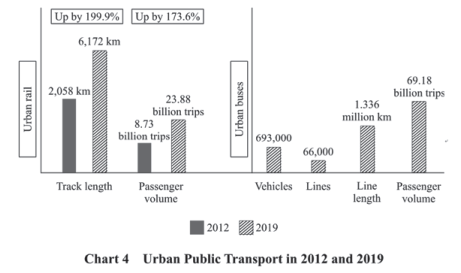Sustainable Development of Transport in China

Panel 6 China's High-Speed Rail

China has built a complete technological system for high-speed rail-its overall engineering level is in the vanguard of international standards and in some sectors its technological strength even leads the world. By the end of 2019, the total length of high-speed railway lines across the country exceeded 35,000 km, making up more than two thirds of the world's total. It has created basic "travel circles" that take one to four hours to commute between large/medium-sized cities and adjacent ones, and 30 minutes to two hours to commute within city clusters.
With the eight vertical and eight horizontal trunk railway lines as the main corridors, China has built world-class high-speed trains running at 350 km/h on the Beijing-Tianjin, Shanghai-Nanjing, Beijing-Shanghai, Beijing-Guangzhou, and Harbin-Dalian lines. The high-speed trains have operated accident-free for 7.5 billion km. They handled 2.36 billion passengers in 2019.
China's high-speed rail shows how quickly the country is capable of implementing major projects. The high-speed rail is opening new fields for quality economic growth, injecting new vitality into economic and social development, and paving the way to a better life for the Chinese people.
Expedited development of intelligent transport. China is developing transport featuring Internet Plus to fully integrate modern information technology with transport management and services. The country has applied emerging technologies such as 5G, big data, and artificial intelligence to transport infrastructure and equipment, and has made breakthroughs in research and development of intelligent transport. Electronic ticketing and online booking have become increasingly popular in railway, highway, waterway and civil aviation passenger services, the application of IT in transport management has significantly increased. By the end of 2019, 229 airports and major airlines have realized paperless travel.
China has removed all expressway toll booths at provincial borders across the country. Positive results have been achieved in the application of new technologies such as Electronic Toll Collection (ETC) on expressways. By the end of 2019, there were more than 200 million ETC users across the country. Round-the-clock, all-weather and full-coverage monitoring of the road network and information distribution are strengthening.
The BeiDou Navigation Satellite System (BDS) has been applied to 7.6 million vehicles on the road, 33,300 postal and express delivery trucks, 1,369 public service vessels, 10,863 maritime navigation facilities, 109 coastal ground-based augmentation stations, 352 general-purpose aircraft, and three transport aircraft. The Beijing-Zhangjiakou High-speed Rail featuring autopilot is the first in the world to use the BDS. Intelligent highway technologies are further promoted, and intelligent port and shipping technologies are widely used. Intelligent delivery outlets are found everywhere in all major cities, and automated sorting has been adopted by all major distribution centers of express delivery enterprises.
China has released administrative rules on road testing of self-driving vehicles, technical guidelines on the construction of enclosed testing fields for autopilot, and rules on intelligent ships. It has built a test area for unmanned cargo ships and piloted the use of drones in delivery services.
Panel 7 Yangshan Port in Shanghai
Phase IV of Yangshan Port in Shanghai is the world's largest fully automated container terminal. It is a key symbol of China's integration into the global economy. Phase IV of the Yangshan Port covers 2.23 million square meters and has a 2,350-meter wharf for seven container ship berths.
An automated operating system developed in China is being used at the port. It is connected to the data information platforms of Shanghai Port to realize automated traffic scheduling. The port embodies the landmark upgrading of China's port industry in terms of operating models, technology application, and equipment manufacturing.


































